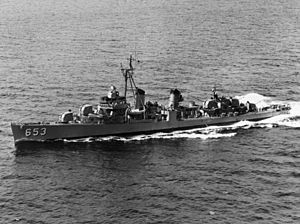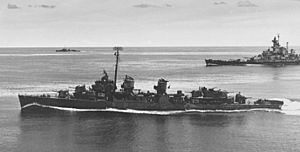USS Knapp facts for kids
 |
|
Quick facts for kids History |
|
|---|---|
| Namesake | Harry Shepard Knapp |
| Builder | Bath Iron Works |
| Laid down | 8 March 1943 |
| Launched | 10 July 1943 |
| Commissioned | 16 September 1943 |
| Decommissioned | 4 March 1957 |
| Stricken | 6 March 1972 |
| Fate | Scrapped, 27 August 1973, but bridge restored and on display at Columbia River Maritime Museum |
| General characteristics | |
| Class and type | Fletcher-class destroyer |
| Displacement | 2,050 tons |
| Length | 376 ft 6 in (114.7 m) |
| Beam | 39 ft 8 in (12.1 m) |
| Draft | 17 ft 9 in (5.4 m) |
| Propulsion |
|
| Speed | 35 knots (65 km/h; 40 mph) |
| Range | 6500 nm at 15 kn (12,000 km at 28 km/h) |
| Complement | 319 |
| Armament |
|
The USS Knapp (DD-653) was a fast and powerful destroyer ship in the United States Navy. It was named after Harry Shepard Knapp, a brave Vice Admiral. The Knapp was the only ship ever named after him. This amazing ship was built by Bath Iron Works in Bath, Maine. Its construction started on March 8, 1943, and it was launched into the water on July 10, 1943. The Knapp officially joined the Navy on September 16, 1943, ready for action.
Contents
Meet the USS Knapp!
A Ship's Beginning
The USS Knapp was a Fletcher-class destroyer. These ships were known for their speed and strong weapons. They played a huge role in many naval battles. The Knapp was built quickly during World War II to help the war effort.
World War II Adventures
Joining the Fight in the Pacific
After some training near Bermuda, the Knapp sailed to the Pacific Ocean in November 1943. It arrived at Pearl Harbor in December. Soon after, in January 1944, the Knapp joined a large group of ships. This group included powerful aircraft carriers led by Admiral Marc Mitscher. Their mission was to invade the Marshall Islands.
The Knapp spent many weeks at sea, protecting the carriers. It also helped by firing its guns at enemy targets on Kwajalein. The ship continued to guard carriers as they launched air attacks on places like Chuuk Lagoon and the Mariana Islands. Later, it helped protect air support for the capture of Emirau Island.
Big Battles and Important Missions
In April 1944, the Knapp supported landings at Jayapura (then called Hollandia). It also helped with air raids on other islands. In May, the ship was part of operations against Saipan. On June 19, the Knapp protected its fleet during the huge Battle of the Philippine Sea. This battle greatly weakened Japan's air force.
The Knapp also took part in raids on Palau, Ulithi, and Iwo Jima. During these missions, it helped sink several Japanese ships. After a short break for repairs, the Knapp was back in action. It helped with the invasion of the Palau Islands in August.

In September, the Knapp protected ships attacking the Philippine Islands. In October, it helped prepare for the Leyte landings by striking Okinawa Island and Taiwan. The ship bravely provided anti-aircraft cover during a big air battle near Taiwan. It even helped protect another ship, the USS Canberra, after it was hit by a torpedo.
The Knapp was also involved in the Battle of Leyte Gulf, one of the largest naval battles in history. It then guarded the USS Reno after it was damaged by torpedoes. From late 1944 to early 1945, the Knapp continued to protect air attacks on Japanese bases. These attacks helped prepare for the Invasion of Lingayen Gulf.
End of the War and Coming Home
After escorting a damaged carrier, the Knapp went to the West Coast for repairs. It returned to the Pacific in May 1945, serving as a radar picket ship near Okinawa. This meant it was an early warning system for enemy planes. Later, it joined carriers for the final attacks on Japan itself.
When the fighting ended on August 15, the Knapp was there. It sailed into Tokyo Bay on September 1, just before the official surrender ceremony. The ship even helped clear out Japanese military equipment during the early days of the occupation. The Knapp then sailed home, arriving in San Diego in December 1945. It was officially taken out of service in July 1946.
Cold War Service
Back in Action
The Knapp was brought back into service on May 3, 1951. This was because of the Korean War, which required more naval ships. It joined the Atlantic Fleet and operated from Newport, Rhode Island. The ship cruised in the Caribbean Sea and later received modern equipment upgrades.
In February 1952, the Knapp sailed with a task force to Europe. It visited England, Norway, and Germany. Later that year, it made a trip to the Mediterranean Sea, stopping in Italy, Turkey, and Spain.
Around the World and Back
After some repairs, the Knapp began a world cruise in August 1953. Its journey was paused when it arrived in the Far East. There, it patrolled the Korean coast until January 1954. The ship then continued its amazing trip, visiting places like Hong Kong, Singapore, Aden, and passing through the Suez Canal. It finally returned to the United States in March 1954.
The Knapp then moved to San Diego. In 1955, it patrolled the East China Sea and the Formosa Straits. It returned to San Diego in June 1955. After more operations along the California coast, it went back to the Far East in 1956. It visited ports like Kobe and Subic Bay before returning to San Diego in May 1956.
A Piece of History Preserved
The USS Knapp was officially taken out of service again on March 4, 1957. It was then placed in the Pacific Reserve Fleet. Even though the ship was eventually scrapped, a special part of it lives on. The bridge of the Knapp is now on display. You can see it at the Columbia River Maritime Museum in Astoria, Oregon. It's a great way to remember this historic ship!
Awards and Recognition
The USS Knapp earned eight battle stars for its brave service during World War II. These stars show how important its missions were.

